
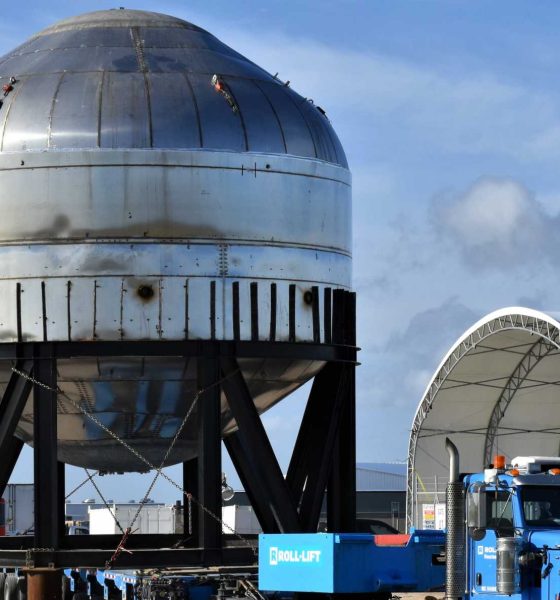
News
SpaceX prepares new Starship tank for explosive test after rapid construction
Over the last few weeks, SpaceX’s South Texas Starship team has been making progress at a pace unprecedented even for the famously agile rocket company and is moving full speed ahead to kick off a new series of explosive tests as early as this morning.
Ever since SpaceX’s original Starship Mk1 prototype spectacularly failed during a November 2019 pressure test, the company has been rapidly rearranging and modifying the development schedule for its next-generation full-reusable rocket. Be it a side effect or coincidence, SpaceX effectively began closing its Florida Starship factory a week after Mk1’s demise and even shipped some of its Florida-built Starship hardware to Texas in recent weeks. However, most of the Florida workforce (up to 80%) was reportedly redirected elsewhere in the company, avoiding layoffs.
Some portion may have even moved to Texas and joined SpaceX’s Starship Boca Chica facilities. Given just how aggressively SpaceX has been expanding its local facilities and preparing new hardware for the next round of improved Starship prototypes, it seems quite likely that the South Texas outpost did indeed receive an influx of skilled workers. Most recently, the company has demonstrated its rapidly growing expertise in the bizarre art of building steel rockets en plein air by fabricating and integrating new tank domes and steel rings and then shipping the curious contraption to its nearby launch site in a matter of weeks from start to finish.
Although it’s difficult to determine the chronology of every single part of the mysterious new tank, it’s fairly safe to say that work on its structure began less than a week before SpaceX CEO Elon Musk tweeted a surprise update, indicating on December 27th that he was in Boca Chica, Texas working all night on “Starship tank dome production”.
In simple terms, the business half of SpaceX’s next-generation Starship upper stage and Super Heavy boosters are comprised of three main parts, shared by almost all launch vehicles. Both are rocket stages that must be as light as physically possible while supporting thousands of tons worth of supercool liquid oxygen and methane propellant. The majority of a simple rocket is ultimately a duo of cylindrical tanks capped by tank domes – also known as bulkheads. The bottom bulkhead of boosters and upper stages also serves as a mounting point for an engine section, where the vehicle’s rocket engines are attached to the rocket body in order to transfer their thrust throughout the rest of the structure.
SpaceX CEO Elon Musk says that Starship tank domes have turned out to be “the most difficult part of [the rocket’s] primary structure” to manufacture, thus explaining why he was apparently assisting the Boca Chica team all night on December 27th.
Starship Mk1 exploded on November 20th, 2019 during a nonflammable propellant loading test, a failure that unofficial videos have compellingly linked to the weld joint connecting the rocket’s upper tank dome to its cylindrical tank. That section of the rocket began leaking cryogenic propellant moments before the entire upper dome tore off the rest of the vehicle and launched hundreds of feet into the air.
All hail Baby Tank
In an apparent response to the unsatisfactory results of Starship Mk1’s manufacturing methods, SpaceX has rapidly initiated an already-planned upgrade of its Starship facilities and manufacturing methods in South Texas, taking delivery of a wealth of new tools over the last several weeks. Most recently, SpaceX’s latest step towards demonstrating that it has substantially improved manufacturing quality arrived in the form of a single propellant tank – the same diameter as Starship Mk1 but much shorter than any possible flight hardware.
Quickly nicknamed Bopper (short for Baby Starhopper) by locals and close followers, the miniature Starship test article came together at a truly spectacular pace. Comprised of two single-weld steel rings and two brand new tank domes, it appears that all four of the components were nothing more than parts and steel stock less than three weeks ago. The first sign of activity came around December 19th, when technicians began placing pressed steel sections onto a bulkhead (dome) assembly jig – used to precisely hold the pieces in the right shape and place as they are welded together.
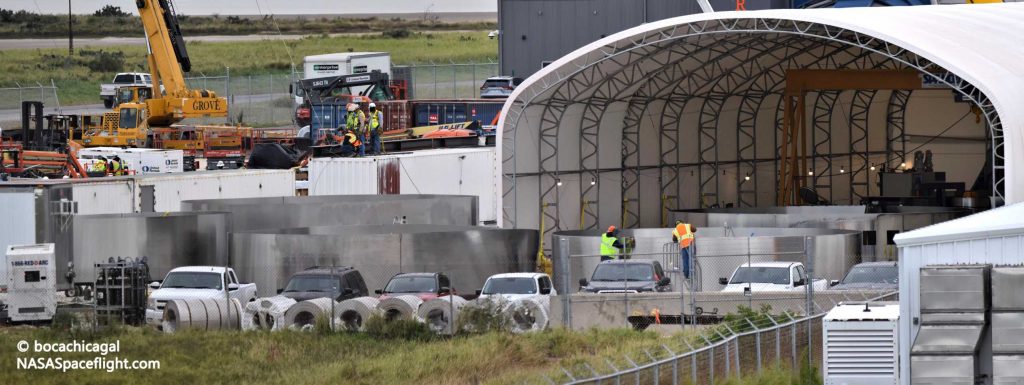
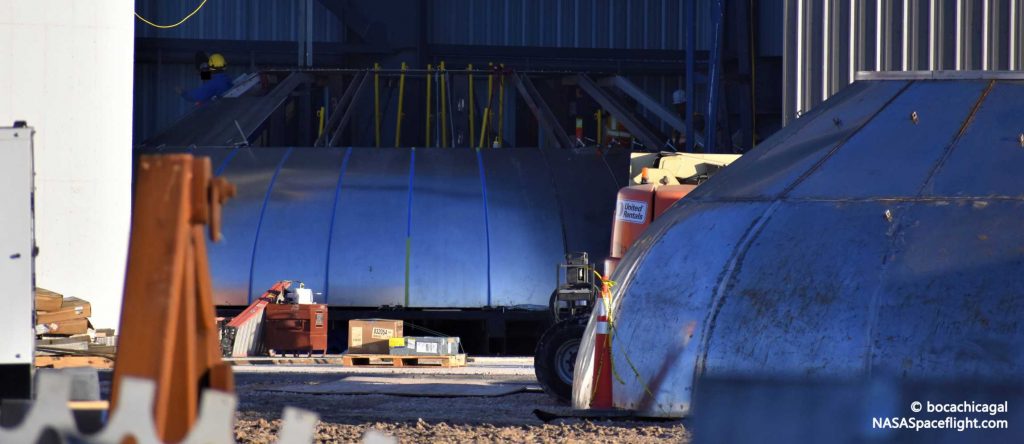
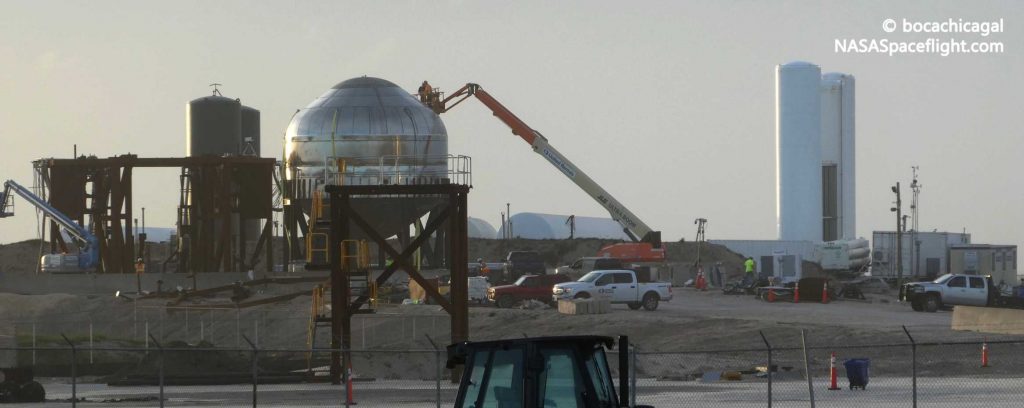
Incredibly, aside from taking less than three weeks to go from miscellaneous parts to an assembled Starship tank delivered to the test site, SpaceX technicians appeared to finish stacking and welding its two halves (each a ring and a dome) perhaps a handful of hours before it was lifted onto a transporter and driven to the launch pad.
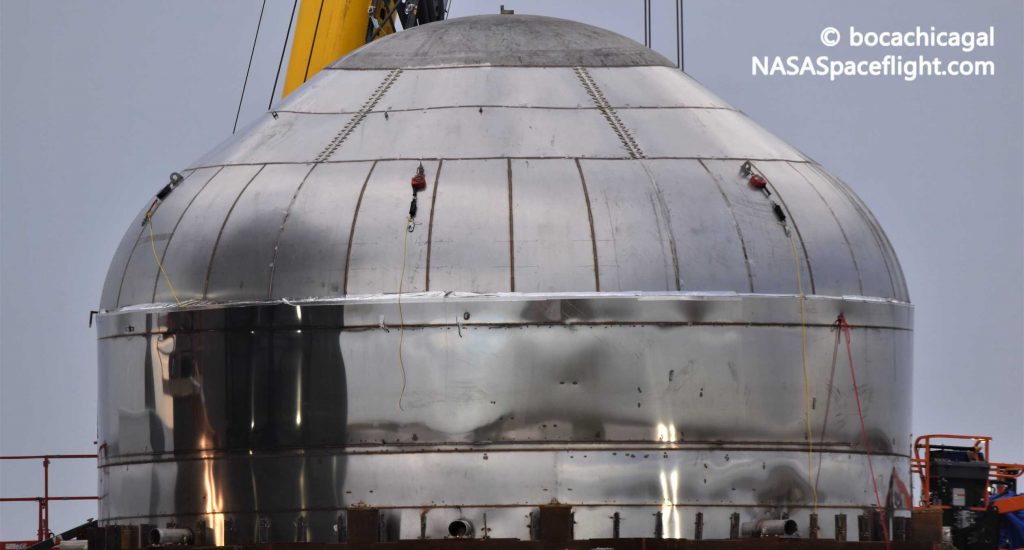
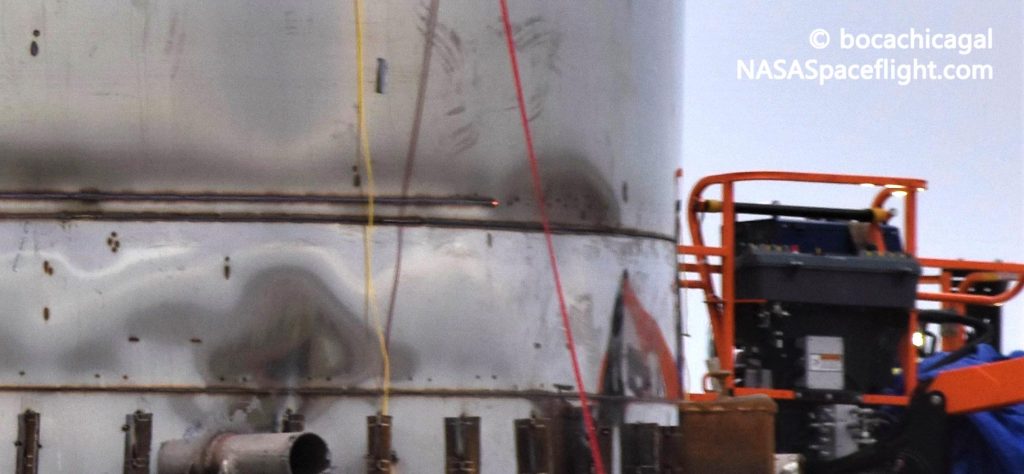
Even for SpaceX, moving a prototype from factory to test site hours after its primary structure was welded together represents an almost unfathomably fast pace of work – truly unfathomable in traditional aerospace. Whether or not such a pace of work is smart, sustainable, or worth it remains to be seen, but SpaceX is nevertheless on track to pressure test its new mini Starship tank as early as this morning, potentially resulting in another spectacular overpressure event (i.e. explosion).
If the tank survives up to or beyond the pressures SpaceX has designed it to, it’s safe to say that the next full-scale Starship prototype could come together far sooner than almost anyone might have expected.
Check out Teslarati’s Marketplace! We offer Tesla accessories, including for the Tesla Cybertruck and Tesla Model 3.

News
Tesla is not sparing any expense in ensuring the Cybercab is safe
Images shared by the longtime watcher showed 16 Cybercab prototypes parked near Giga Texas’ dedicated crash test facility.

The Tesla Cybercab could very well be the safest taxi on the road when it is released and deployed for public use. This was, at least, hinted at by the intensive safety tests that Tesla seems to be putting the autonomous two-seater through at its Giga Texas crash test facility.
Intensive crash tests
As per recent images from longtime Giga Texas watcher and drone operator Joe Tegtmeyer, Tesla seems to be very busy crash testing Cybercab units. Images shared by the longtime watcher showed 16 Cybercab prototypes parked near Giga Texas’ dedicated crash test facility just before the holidays.
Tegtmeyer’s aerial photos showed the prototypes clustered outside the factory’s testing building. Some uncovered Cybercabs showed notable damage and one even had its airbags engaged. With Cybercab production expected to start in about 130 days, it appears that Tesla is very busy ensuring that its autonomous two-seater ends up becoming the safest taxi on public roads.
Prioritizing safety
With no human driver controls, the Cybercab demands exceptional active and passive safety systems to protect occupants in any scenario. Considering Tesla’s reputation, it is then understandable that the company seems to be sparing no expense in ensuring that the Cybercab is as safe as possible.
Tesla’s focus on safety was recently highlighted when the Cybertruck achieved a Top Safety Pick+ rating from the Insurance Institute for Highway Safety (IIHS). This was a notable victory for the Cybertruck as critics have long claimed that the vehicle will be one of, if not the, most unsafe truck on the road due to its appearance. The vehicle’s Top Safety Pick+ rating, if any, simply proved that Tesla never neglects to make its cars as safe as possible, and that definitely includes the Cybercab.
Elon Musk
Tesla’s Elon Musk gives timeframe for FSD’s release in UAE
Provided that Musk’s timeframe proves accurate, FSD would be able to start saturating the Middle East, starting with the UAE, next year.

Tesla CEO Elon Musk stated on Monday that Full Self-Driving (Supervised) could launch in the United Arab Emirates (UAE) as soon as January 2026.
Provided that Musk’s timeframe proves accurate, FSD would be able to start saturating the Middle East, starting with the UAE, next year.
Musk’s estimate
In a post on X, UAE-based political analyst Ahmed Sharif Al Amiri asked Musk when FSD would arrive in the country, quoting an earlier post where the CEO encouraged users to try out FSD for themselves. Musk responded directly to the analyst’s inquiry.
“Hopefully, next month,” Musk wrote. The exchange attracted a lot of attention, with numerous X users sharing their excitement at the idea of FSD being brought to a new country. FSD (Supervised), after all, would likely allow hands-off highway driving, urban navigation, and parking under driver oversight in traffic-heavy cities such as Dubai and Abu Dhabi.
Musk’s comments about FSD’s arrival in the UAE were posted following his visit to the Middle Eastern country. Over the weekend, images were shared online of Musk meeting with UAE Defense Minister, Deputy Prime Minister, and Dubai Crown Prince HH Sheikh Hamdan bin Mohammed. Musk also posted a supportive message about the country, posting “UAE rocks!” on X.
FSD recognition
FSD has been getting quite a lot of support from foreign media outlets. FSD (Supervised) earned high marks from Germany’s largest car magazine, Auto Bild, during a test in Berlin’s challenging urban environment. The demonstration highlighted the system’s ability to handle dense traffic, construction sites, pedestrian crossings, and narrow streets with smooth, confident decision-making.
Journalist Robin Hornig was particularly struck by FSD’s superior perception and tireless attention, stating: “Tesla FSD Supervised sees more than I do. It doesn’t get distracted and never gets tired. I like to think I’m a good driver, but I can’t match this system’s all-around vision. It’s at its best when both work together: my experience and the Tesla’s constant attention.” Only one intervention was needed when the system misread a route, showcasing its maturity while relying on vision-only sensors and over-the-air learning.
News
Tesla quietly flexes FSD’s reliability amid Waymo blackout in San Francisco
“Tesla Robotaxis were unaffected by the SF power outage,” Musk wrote in his post.

Tesla highlighted its Full Self-Driving (Supervised) system’s robustness this week by sharing dashcam footage of a vehicle in FSD navigating pitch-black San Francisco streets during the city’s widespread power outage.
While Waymo’s robotaxis stalled and caused traffic jams, Tesla’s vision-only approach kept operating seamlessly without remote intervention. Elon Musk amplified the clip, highlighting the contrast between the two systems.
Tesla FSD handles total darkness
The @Tesla_AI account posted a video from a Model Y operating on FSD during San Francisco’s blackout. As could be seen in the video, streetlights, traffic signals, and surrounding illumination were completely out, but the vehicle drove confidently and cautiously, just like a proficient human driver.
Musk reposted the clip, adding context to reports of Waymo vehicles struggling in the same conditions. “Tesla Robotaxis were unaffected by the SF power outage,” Musk wrote in his post.
Musk and the Tesla AI team’s posts highlight the idea that FSD operates a lot like any experienced human driver. Since the system does not rely on a variety of sensors and a complicated symphony of factors, vehicles could technically navigate challenging circumstances as they emerge. This definitely seemed to be the case in San Francisco.
Waymo’s blackout struggles
Waymo faced scrutiny after multiple self-driving Jaguar I-PACE taxis stopped functioning during the blackout, blocking lanes, causing traffic jams, and requiring manual retrieval. Videos shared during the power outage showed fleets of Waymo vehicles just stopping in the middle of the road, seemingly confused about what to do when the lights go out.
In a comment, Waymo stated that its vehicles treat nonfunctional signals as four-way stops, but “the sheer scale of the outage led to instances where vehicles remained stationary longer than usual to confirm the state of the affected intersections. This contributed to traffic friction during the height of the congestion.”
A company spokesperson also shared some thoughts about the incidents. “Yesterday’s power outage was a widespread event that caused gridlock across San Francisco, with non-functioning traffic signals and transit disruptions. While the failure of the utility infrastructure was significant, we are committed to ensuring our technology adjusts to traffic flow during such events,” the Waymo spokesperson stated, adding that it is “focused on rapidly integrating the lessons learned from this event, and are committed to earning and maintaining the trust of the communities we serve every day.”








